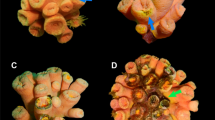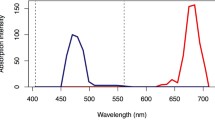Abstract
White syndromes (WS) are among the most prevalent coral diseases, and are responsible for reef demise on the Great Barrier Reef. The disease manifests as a clear differentiation between tissue and exposed skeleton and results in rapid tissue loss. Fluorescence in situ hybridisation (FISH) was used in conjunction with histology and transmission electron microscopy (TEM) to investigate bacterial communities and cell death associated with WS. No evidence of bacterial communities or microbial association (using six bacterial probes, TEM and histopathology) was evident within the lesion or adjacent tissues, despite the presence of dense possible secondary invaders in the exposed skeletal regions. Despite widespread reference to necrosis in coral disease literature, there was no evidence of necrosis in any WS lesion or the adjacent tissues in this study. However, in situ end labelling, light microscopy and TEM of WS and healthy coral tissue sections showed evidence of extensive programmed cell death (PCD) exclusively in WS. This study provides the first evidence of intrinsic or PCD as a primary mechanism of cell death in WS, and may provide some explanation for the failure to isolate pathogens from over 80% of identified coral diseases, many of which show similar lesion patterns and WS characteristics.






Similar content being viewed by others
References
Adle-Biassette H, Bell JE, Creange A, Sazdovitch V, Authier FJ, Gray F, Hauw J-J, Gherardi R (1998) DNA breaks detected by in situ end labeling in dorsal root ganglia of patients with AIDS. Neuropath Appl Neurobiol 24:373–380
Ainsworth TD, Fine M, Blackall LL, Hoegh-Guldberg O (2006) Fluorescence in situ hybridisation and spectral imaging of coral associated bacterial communities. Appl Env Micro 72(4):3016–3020
Amersien JC (2002) On the origin, evolution, and nature of programmed cell death, a timeline of four billion years. Cell Death Differ 9:367–393
Amman R, Snaidr J, Wagner M, Ludwig W, Scleifer KH (1996) In situ visualization of high genetic diversity in a natural microbial community. J Bacteriol 178:3496–3500
Antonius A (1973) New observations on coral destruction in reefs. Abs Assoc Isl Mar Lab Caribb10:3
Antonius A (1977) Coral mortality in reefs: a problem for science and management. Proc 3rd Int Coral Reef Symp Miami 2:617–623
Antonius A (1981) The ‘band’ diseases in coral reefs. Proc 4th Int Coral Reef Symp Philippines 2:7–14
Antonius A, Riegl B (1997) A possible link between coral diseases and a corallivorous snail (Drupella cornus) outbreak in the Red Sea. Atoll Res Bull 447:1–9
Antonius A, Riegl B (1998) Coral diseases and Drupella cornus invasion in the Red Sea. Coral Reefs 17:48
Aronson RB, Precht WF (2001) White-band diseases and the changing face of Caribbean coral reefs. Hydrobiologia 460:25–38
Banin E, Israely T, Fine M, Loya Y, Rosenberg (2001) Role of endosymbiotic zooxanthellae and coral mucus in the adhesion of the coral-bleaching pathogen Vibrio shiloi to its host. FEMS Microbiol Lett 199:33–37
Ben-Haim Y, Rosenberg E (2002) A novel Vibrio sp pathogen of the coral Pocillopora damicornis. Mar Biol 141:47–55
Böhm I, Schild H (2003) Apoptosis: the complex scenario for a silent cell death. Mol Imaging Biol 5(1):2–14
Bythell JC, Barer MR, Cooney RP, Guest JR, O’Donnell AG, Pantos O, Le Tissier MDA (2002) Histopathological methods for the investigation of microbial communities associated with disease lesions in reef corals. Lett Appl Microbiol 34:359–364
Bythell JC, Pantos O, Richardson L (2004) White plague, White Band and other “White” diseases. In: Rosenberg E, Loya Y (eds) Coral health and disease. Springer, Berlin Heidelberg New York
Corcoran GB, Fix L, Jones DP, Moslen MT, Nicoters P, Oberhammer FA, Buttyan R (1994) Contemporary issues in toxicology. Apoptosis: molecular control point in toxicity. Toxicol Appl Pharmacol 128:169–181
Cristea IM, Esposti MD (2004) Membrane lipids and cell death: an overview. Chem Phys Lipids 129:133–160
Denner EBM, Smith G, Busse HJ, Schumann P, Narzt T, Polson SW, Lubitz W, Richardson LL (2003) Aurantimonas coralicida gen. nov., sp. nov., the causative agent of white plague type II on Caribbean scleractinian corals. Int J Syst Evol Microbiol 53:1115–1122
van Doom WG, Woltering EJ (2004) Senescence and programmed cell death: substance or semantics. J Exp Bot 55(406):2147–2153
Dunn SR, Bythell JC, Le Tissier MDA, Burnett WJ, Thomason JC (2002) Programmed cell death and cell necrosis activity during hyperthermic stress induced bleaching of the symbiotic sea anemone Aiptasia sp. J Exp Mar Biol Ecol 272:29–53
Dunn SR, Thomason JC, Le Tissier MDA, Bythell JC (2004) Heat stress induces different forms of cell death in sea anemones and their endosymbiotic algae depending on temperature and duration. Cell Death Differ 11:1213–1222
Essbauer S, Ahne W (2002) The epizootic haematopoitic necrosis virus (Iridoviridae) induces apoptosis in vitro. J Vet Med B 49:25–30
Foster JS, Apicella MA, McFall-Ngai MJ (2000) Vibrio fisheri lipopolysaccharide induces developmental apoptosis, but not complete morphogenesis, of the Euprymna scolopes symbiotic light organ. Dev Biol 226:242–254
Gao LY, Kwaik Y (2000) The modulation of host cell apoptosis by intracellular bacterial pathogens. Trends Microbiol 8(7):306–313
Glynn PW, Peters EC, Muscatine L (1985) Coral tissue microstructure and necrosis: relation to catastrophic coral mortality in Panama. Dis Aquat Org 1:29–37
Green EP, Bruckner AW (2000) The significance of coral disease epizootiology for coral reef conservation. Biol Conserv 96:347–361
Harvell CD, Kim K, Burkholder JM, Colwell RR, Epstein PR, Grimes EE et al (1999) Emerging marine diseases—climate links and anthropogenic factors. Science 285:1505–1510
Harvell CD, Mitchell CE, Ward JR, Altizer S, Dobson AP, Ostfeld RS, Samuel MD (2002) Climate warming and disease risks for terrestrial and marine biota. Science 296:2158–2162
Holden C (1996) Coral disease hot spot in the Florida Keys. Science 274:2017
Hughes TP (1994) Catastrophes phase shifts and large-scale degradation of a Caribbean coral reef. Science 265:1547–1551
Kerr JF, Wyllie HA, Currie AR (1972) Apoptosis; a basic biological phenomenon with wide-ranging implications in tissue kinetics. Br J Cancer 26:239–257
Kim K, Harvell CD, Kim PD, Smith GW, Merkel SM (2000a) Fungal disease resistance of Caribbean sea fan corals (Gorgonia spp). Mar Biol 36:259–267
Kim K, Kim PD, Alker AP, Harvell CD (2000b) Chemical resistance of gorgonian corals against fungal infections. Mar Biol 137:393–401
Kushmaro A, Loya Y, Fine M, Rosenberg E (1996) Bacterial infection and coral bleaching. Nature 380:396
Kushmaro A, Rosenberg E, Fine M, Loya Y (1997) Bleaching of the coral Oculina patagonica by Vibrio AK-1. Mar Ecol Prog Ser 147:159–165
Kushmaro A, Rosenberg E, Fine M, Ben-Haim Y, Loya Y (1998) Effect of temperature on bleaching of the coral Oculina patagonica by Vibrio shiloi AK-1. Mar Ecol Prog Ser 171:131–137
Kushmaro A, Banin E, Loya Y, Stackebrandt E, Rosenberg E (2001) Vibrio shiloi sp nov the causative agent of bleaching of the coral Oculina patagonica. Int J Syst Evol Microbiol 51:1383–1388
Lam E, Pontier D, del Pozo O (1999) Die and let live—programmed cell death in plants. Curr Opin Plant Biol 2:502–507
Le Tissier MDA (1990) The ultrastructure of the skeleton and skeletogenic tissues of the temperate coral Caryophyllia smithii. J Mar Biol Assoc U.K 70:295–310
Manz W, Amann R, Ludwig W, Wagner M, Schleifer KH (1992) Phylogenetic oligonucleotide probes for the major subclasses of proteobacteria: problems and solutions. Syst Appl Microbiol 15:593–600
Manz W, Arp G, Schumann-Kindel G, Szemzyke U, Reitner J (2000). Widefield deconvolution epifluorescence microscopy combined with fluorescence in situ hybridisation reveals the spatial arrangement of bacteria in sponge tissue. J Micro Method 40:125–134
McFall-Ngai MJ (1999) Consequences of evolving with bacterial symbionts: insights from the squid–vibrio associations. Annu Rev Ecol Syst 30:235–256
Mittler R, Simon L, Lam E (1997) Pathogen-induced programmed cell death in tobacco. J Cell Sci 110:1333–1344
Mullen KM, Peters EC, Harvell CD (2004) Coral resistance to disease. In: Rosenberg E, Loya Y (eds) Coral health and disease. Springer, Berlin Heidelberg New York
Peters EC (1984) A survey of cellular reactions to environmental stress and disease in Caribbean scleractinian corals. Helgol Meeresunters 37:113–137
Peters EC, Oprandy JJ, Yevich PP (1983) Possible causal agent of “white band disease” in Caribbean acroporids corals. J Invertebr Pathol 41:394–396
Raffray M, Cohen GM (1997) Apoptosis and necrosis in toxicology: a continuum or distinct modes of cell death. Pharmacol Ther 75(3):153–177
Richardson LL, Kuta KG (2003) Ecological physiology of the black band disease cyanobacterium Phormidium coalllyticum, FEMS Microbiol Ecol 43:287–298
Richardson LL, Goldberg WM, Carlton RG, Halas JC (1998a) Coral disease outbreak in the Florida Keys: plague type II. Rev Biol Trop 46:187–198
Richardson LL, Goldberg WM, Kuta KG, Aronson RB, Smith GW, Ritchie KB, Halas JC et al (1998b) Florida’s mystery coral killer identified. Nature 392:557–558
Richardson LL, Smith GW, Ritchie KB, Carlton RG (2001) Integrating microbiological microsensor molecular and physiologic techniques in the study of coral disease pathogenesis. Hydrobiologia 460:71–89
Roff G, Hoegh-Guldberg O, Fine M (2006) Intracolonial response to Acroporid “white syndrome” lesions in tabular Acropora spp. (Scleractinia). Coral Reefs: Online First
Roller C, Wagner M, Amann R, Ludwig W, Schleifer KH, (1994) In situ probing of gram positive bacteria with hight G + C content using 23S rRNA-targeted oligonucleotides. Microbiology 140 2849–2858
Rosenberg E, Ben-Haim Y (2002) Microbial diseases of corals and global warming. Environ Microbiol 4(6):318–326
St John JA, Tisay KT, Caras IW, Key B (2000) Expression of EphA5 during development of the olfactory nerve pathway in rat. J Comp Neurol 416:540–550
Sutherland KP, Porter JW, Torres C (2004) Disease and immunity in Caribbean and Indo-pacific zooxanthellate corals. Mar Ecol Prog Ser 266:273–302
Syntichaki P, Tavernarakis N (2002) Death by necrosis: uncontrollable catastrophe, or is there order behind the chaos? EMBO Reports 3(7):604–609
Thompson FL, Iida T, Swings J (2004) Biodiversity of Vibrios. Microbiol Mol biol rev 68(3):403–431
Wagner M, Horn M, Daims H (2003) Fluorescence in situ hybridization for the identification and characterization of prokaryotes. Curr Opin Microbiol 6:302–309
Willis BL, Page CA, Dinsdale EA (2004) Coral disease on the Great Barrier Reef. In: Rosenberg E, Loya Y (eds) Coral health and disease. Springer, Berlin Heidelberg New York
Winkler R, Antonius A, Renegar DA (2004) The skeleton eroding band disease on coral reefs of Aqaba, Red Sea. Mar Ecol 25(2):129–144
Wyllie AH, Kerr JFR (1980) Cell death: the significance of apoptosis. Int Rev Cytol 68:251–306
Acknowledgments
The authors are grateful for support provided by the GEF Coral Reef Targeted Research Program (http://www.gefcoral.org) and the ARC Centre of Excellence for Coral Reef Studies. The authors would like to thank the Centre for Advanced Light Microscopy at the University of Queensland, and also Dr Clay Winterford and Professor Glenda Gobe, of The Queensland Institute for Medical Research, Brisbane, Australia
Author information
Authors and Affiliations
Corresponding author
Additional information
Communicated by M. Kühl, Helsingør.
Rights and permissions
About this article
Cite this article
Ainsworth, T.D., Kvennefors, E.C., Blackall, L.L. et al. Disease and cell death in white syndrome of Acroporid corals on the Great Barrier Reef. Mar Biol 151, 19–29 (2007). https://doi.org/10.1007/s00227-006-0449-3
Received:
Accepted:
Published:
Issue Date:
DOI: https://doi.org/10.1007/s00227-006-0449-3




